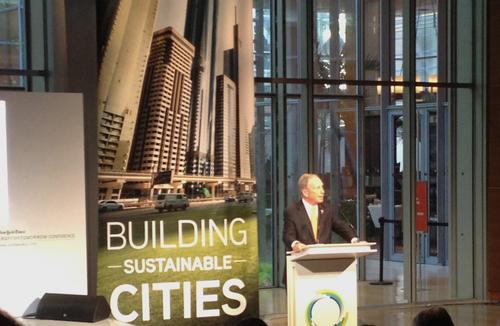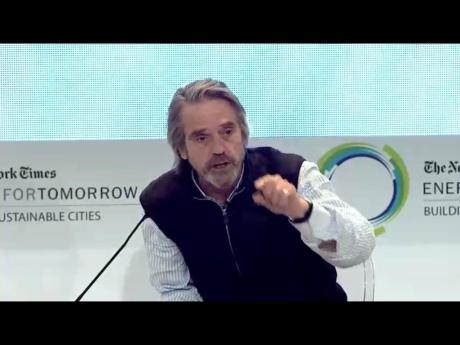The New York Times “Energy for Tomorrow” conference opened with a keynote speech by Mayor Michael Bloomberg, who stressed the need for cities to act now to build a more sustainable future. To the audience at the ticketed event and over live stream, he described an urban future where, by 2050, 75 percent of the world’s population will be living in cities. Historically, cities have encouraged freedom and the formation of knowledge, and Bloomberg linked this to the progress on sustainability that cities, as opposed to the federal government, are making. He touted his own personal involvement with the Sierra Club’s campaign to retire one-third of the nation’s 500 coal fired power plants by 2020; so far 144 have been closed. Bloomberg chalked up some of this success to the expansion of natural gas and said he is “in favor of fracking, but not in our watershed… we all have to make decisions–there’s no free lunch.”

Mayor Bloomberg laid out his guidelines for how New York City has moved its sustainability goals forward and how other major cities can achieve their aims:
- Develop a plan with ambitious, achievable, measurable goals such as PlaNYC 2030. He especially emphasized the need for metrics to calculate the impact of sustainability. Scientists and policy makers can argue about the impact of climate change but as long as your metrics are sound no one can argue with your conclusions, he stated.
- City governments need innovation, creativity, support, and strength to push policies through because they are not always popular at first. In other words, it is important to use private sector skills and resources to achieve your goals, too. Bloomberg offered an example of New York’s latest public-private partnership: the Food Waste Challenge, where over 100 restaurants will be diverting their food waste to compost. “The program will help meet the City’s PlaNYC goals to divert 75 percent of all solid waste from landfills by 2030 and reduce greenhouse gas emissions. Food waste comprises one-third of the city’s more than 20,000 tons of daily refuse and restaurants account for 70 percent of commercial food waste. Participating restaurants have pledged to reduce 50 percent of the food waste they send to landfills through composting and other waste prevention strategies” according to the press release from the Mayor’s office. Bloomberg also described a new public-private partnership to expand the community garden network by allowing gardening organizations to use nine acres of under-utilized city land.
- “Be a thief.” In other words, steal the best ideas from around the world, such as bike share, and use them to improve your own city.
In regards to Hurricane Sandy, the Mayor urged immediate action and said “climate change may or may not have caused Hurricane Sandy” but there is no question it was intensified by warming waters and higher seas. He stated the necessity of New York City re-engineering its energy infrastructure, and expanding its green infrastructure. More policy recommendations related to Hurricane Sandy will be announced in the forthcoming Mayor’s Report, due at the end of May.
Mayor Bloomberg concluded his remarks by urging cities to be at the forefront of environmental change, and cautioning city leaders not to walk away from an extensive environmental agenda. Sustainable environmental choices are good for the economy, he said, and that is how they should be sold to concerned constituents. He advised leaders to focus on the short-term, and not to worry about the world fifty years from now because we have plenty of reasons to act now to improve the world.
Mayors’ Panel: How do we Reinvent our Cities for the Third Industrial Revolution?
The city of 2025 could be crisis-ridden if the world doesn’t create more sustainable models of urban development. Research says that our cities will continue to expand and increase in population, while their populations will bring rising consumption and emissions. Alongside these huge challenges, there are also opportunities for businesses: electric vehicles, new low-carbon means of cooling, and energy efficient buildings. We ask a group of mayors to outline an urban planning strategy for 2025.
Moderator Bill Keller opened the panel discussion by asking each mayor or former mayor to give a general overview of sustainability initiatives they had pursued in their cities.
Jaime Lerner, the former mayor of Curitiba, Brazil, spoke about developing their Bus Rapid Transit (BRT) system, and called cars “the cigarette of the future.” Stephanie Miner, the mayor of Syracuse, New York, described the need to integrate sustainability into every decision made by the city agencies and the importance of keeping a “big picture” view.
Enrique Peñalosa, the former mayor of Bogota, Colombia, described Bogota’s BRT system, and their famous bicycle highways: a 60 kilometer long, 15 meter wide network that runs throughout the city exclusively for cyclists. Peñalosa emphasized the equity component of sustainability when it comes to decisions about distributing road space between cars, bikes, pedestrians, and mass transit.
Finally, Greg Stanton, the mayor of Phoenix, Arizona, spoke about initiatives to address the large amount of vacant land in Phoenix; a whopping 43 percent of the land within the city is vacant. One of the largest vacant parcels is being turned into an urban garden with help from the International Refugee Committee. Stanton’s goals for this and other sustainability projects are to be “positive and replicable” and he emphasized the need to “integrate sustainable thinking in our entire culture.”
How do you sustain programs in the face of changing politics, economics, migration, and other urban problems?
Lerner cautioned leaders to “not project tragedy” and to invest one’s energy in changing the current paradigm. He advocated a system of mobility that combines all modes of transport, using smaller cars, and using incentives to encourage bus use.
Miner encouraged starting with small benchmarks to prove that sustainability initiatives can work, and then moving on to a larger, comprehensive plan because other people get too overwhelmed with the changes.
In contrast, Peñalosa advocated for a more comprehensive approach because “in the end people like it even if they don’t at first.” He again emphasized equity concerns and the importance of involving all parts of the city in decision making for each neighborhood. He believed that buses should have priority road space and whatever is left should be divided up for cars, pedestrians, and bicycles. He cited an example of one day a year when Bogota is a car-free city, and everyone still gets to work using public transit. He called public transit riders “heroes.” Finally, he discussed bike lanes and said they “need to be more than a cute architectural feature and should be a right like a sidewalk.”
Greg Stanton questioned the “sustainability of sustainability” on the federal stage, and mentioned its importance on the city level, especially to young people. He said that young people want to move to cities where long-term sustainability is part of the comprehensive plan, and therefore pursuing sustainability initiatives on the local level is good for the economy.
What are the major obstacles to implementing sustainability policies?
“Everyone in the city has to understand the idea or scenario that you are proposing” said Lerner. He equated small projects to “urban acupuncture,” which are small projects that provide a jolt of energy for the whole process of planning. He also said it is the city’s responsibility to be more effective since that is where most of the world’s population resides. He cited three basic things that everyone can do: use less cars, separate our garbage, and live closer to work or bring work closer to us.
Miner said that the biggest obstacle is that all policy decisions are made in a bureaucracy that has designed cities for cars and not for green infrastructure. She described the challenges as “constantly going uphill to fight the battle” to bring sustainability into the governmental thought process. Miner also said she would welcome the state and federal government to partner with Syracuse, but that they cannot wait for them to do so.
Stanton echoed Miner’s attitude towards the federal government when he said “we wrote off the federal government a long time ago.” He believes that cities are on their own and are going to have to lead without state or federal backing. As the mayor of a city in a very conservative state it is even more important to be a leader on sustainability issues since it is not a priority on the state level, Stanton said.
How do you propose funding these sustainability ideas?
The two American mayors, Miner and Stanton, advocated using tax breaks as leverage and public-private partnerships to fund sustainability projects. In Syracuse, tax breaks are only given to developers that use LEED standards. Stanton touted the public-private partnership example of Solar Phoenix 2, the most successful home solar company in the U.S. He also emphasized pursuing projects that ultimately save cities money, such as recycling and bike share programs.
Peñalosa talked about the problems associated with rising land costs that force people into slums or far from the city, which forces them to be dependent on cars for transportation. He advocated for government intervention to buy land because “cities must grow in the right places.” Lerner succinctly stated his funding strategy: “cut one zero off and you have creativity, cut two off and you have sustainability.”
Jeremy Irons discusses his film “Trashed” with New York Times columnist Andrew Revkin
The documentary feature film “Trashed” highlights solutions to the pressing environmental problems facing us all. Academy Award-winning actor Jeremy Irons has teamed up with British filmmaker Candida Brady to record the devastating effect that pollution has had on some of the world’s most beautiful destinations.
Jeremy Irons passionately discussed wanting to use the medium of film to educate and raise awareness about a “curable subject.” He offered several policy recommendations: stop incinerating trash, compost food wastes, and reduce packaging. He encouraged New Yorkers to aim for zero waste—San Francisco recycles 80 percent of their wastes, while New York is around a measly 15 percent. Irons instructed consumers to never use plastic bags (which take around 500 years to decompose), and to remove excessive packaging from items they purchase in the store to send a message to manufacturers to reduce packaging.

Irons also talked about environmental and justice issues related to electronic waste, such as old computers that end up burned in Africa. His solution is for the burden to be on manufacturers to take back old electronics and demolish or reuse them safely. He repeated that industries should have to prove that their products are 100 percent safe rather than consumers demanding this of manufacturers.
He cited environmental and social concerns like beached orca whales whose bodies are completely toxic, children with increased rates of Attention Deficit Disorder (ADD) and allergies, and chemicals being emitted from incinerators of which we don’t know the effects. He connected the dots of excessive consumption and waste to overarching problems with our “throw-away” culture today. Irons decried the “unholy sin” of buying something and then tossing it away, and cautioned that we need to value everything for its quality—from relationships to material objects—and to rethink the attitude towards the way we live.